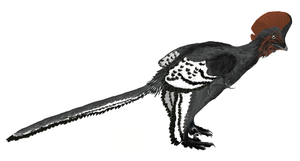Tetrapterygidae
| Tetrapterygids Temporal range: Late Jurassic–Late Cretaceous, 161–120 Ma | |
|---|---|
 | |
| Life reconstruction of Anchiornis huxleyi | |
| Scientific classification | |
| Kingdom: | Animalia |
| Phylum: | Chordata |
| Class: | Reptilia |
| Clade: | Dinosauria |
| Order: | Saurischia |
| Suborder: | Theropoda |
| Clade: | Averaptora |
| Family: | †Tetrapterygidae Chatterjee, 2015 |
| Subgroups | |
Tetrapterygidae (meaning "four-wings") is a group of four-winged dinosaurs proposed by Sankar Chatterjee in the second edition of his book The Rise of Birds: 225 Million Years of Evolution, where he included Microraptor, Xiaotingia, Aurornis, and Anchiornis.[1] The group was named after the characteristically long flight feathers on the legs of all included species, as well as the theory that the evolution of bird flight may have gone through a four-winged (or "tetrapteryx") stage, first proposed by naturalist William Beebe in 1915.[2] Chatterjee suggested that all dinosaurs with four wings formed a natural group exclusive of other paravians, and that this family was the sister taxon to the group Avialae, although most phylogenetic analyses have placed the animals of his Tetrapterygidae elsewhere in Paraves, such as Xiaotingia, Aurornis, and Anchiornis being placed in Avialae.[3]
Here below is a diagram showing the proposed relationships within the family:
| †Tetrapterygidae |
| |||||||||||||||||||||
| |
References
- ↑ Chatterjee, S. (2015). The Rise of Birds: 225 Million Years of Evolution, second edition. Johns Hopkins University Press.
- ↑ Beebe, C. W. A. (1915). "Tetrapteryx stage in the ancestry of birds." Zoologica, 2: 38-52.
- ↑ Lefèvre, U.; Hu, D.; Escuillié, F. O.; Dyke, G.; Godefroit, P. (2014). "A new long-tailed basal bird from the Lower Cretaceous of north-eastern China". Biological Journal of the Linnean Society. 113 (3): 790–804. doi:10.1111/bij.12343.